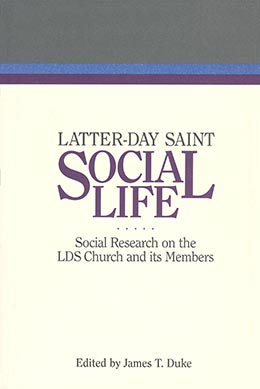The Religiosity of Mormon Men and Women through the Life Cycle
James T. Duke and Barry L. Johnson
James T. Duke and Barry L. Johnson, “The Religiosity of Mormon Men and Women through the Life Cycle,” in Latter-day Saint Social Life: Social Research on the LDS Church and its Members (Provo, UT: Religious Studies Center, Brigham Young University, 1998), 315–344.
James T. Duke and Barry L. Johnson are professors of sociology at Brigham Young University. This article was originally published in BYU Studies 36:139–58; reprinted with permission.
Abstract
Personal religious commitment often changes as a result of transitions through life cycle stages such as marriage, parenthood, and retirement. Using a survey of active LDS respondents, this study found that LDS women were more religious than LDS men on twenty-six of thirty-one questions. The authors identified nine life cycle stages and studied changes in each of seven religious factors plus overall religiosity. This essay shows that the religiosity of men exhibits a different pattern than that of women, with men experiencing more changes in early life cycle stages and women undergoing additional changes in later life. Religiosity is typically high among newly married people, somewhat lower for people in the childrearing years, and higher again at retirement and widowhood.
Do the religious beliefs and commitments of Latter-day Saints change during the course of their lives, and if so, how much do they change? Do the Saints grow in religious devotion as they grow older, especially as they approach death? Do marriage, children, retirement, and widowhood change their religious beliefs and behavior in positive or negative ways? Do these experiences have a different effect on men than on women? This study seeks to answer such questions by investigating the religious behavior and commitment of LDS people during the life cycle from young adulthood to old age.
Social researchers have learned much about personal religious commitment and behavior, or what they refer to by the dreadful term “religiosity,” and what we will usually call “religious devotion” in this paper. Researchers have found that people have many ways of being religious. That is, there are many different dimensions of religiosity, such as church attendance; prayer and gospel study; beliefs in God, the devil, and life after death; knowledge of scriptures and doctrines; and having spiritual experiences. Not all people are religious in the same way. Some people always attend church but rarely read the scriptures, while others provide wonderful service to others but rarely attend church services.
A study of religious devotion among Latter-day Saints by Albrecht and Cornwall (1989) showed that positive religious events such as receiving a priesthood blessing, or positive life events such as improved relationships with a spouse or child, influence religious devotion in a positive direction. On the other hand, negative religious events such as committing sin or having conflict with church leaders, as well as negative life events such as illness, unemployment, or the death of a relative, usually have the opposite effect of decreasing religious devotion. However, negative events that happen to others usually influence people to be more religious.
In this paper, we explore two aspects of the religious devotion of Latter-day Saints: gender differences in religiosity and religiosity through the family life cycle. But first we will discuss how the study was conducted.
Methodology
We conducted a survey of a national sample of Mormon families, using the subscription list of a major LDS publication. A random sample of 1,026 households was selected. Each state was represented in proportion to its population except the state of Utah, whose proportion was cut in half to ensure that Utah Latter-day Saints would not predominate in the study. Our sample therefore was composed primarily of active Latter-day Saints.
Two questionnaires were mailed to each address with a cover letter asking that they be filled out by the husband and wife (Dillman 1978). If either the husband or wife was not present in the household, we asked the head of the household to complete the questionnaire and to share the other questionnaire with another adult person. Three follow-up mailings were used to encourage everyone to respond. A total of 1,384 usable questionnaires were received, representing 80 percent of all households sampled. The questionnaire contained a number of questions measuring various dimensions of religious behavior and attitudes.
Religious Devotion and Social Influences
Some types of Americans are, on the average, more religious than others. Belief in Christ, for example, is higher among women than men, older people in contrast to younger people, people living in the South, non-whites, and people with less education and income (Gallup 1993, p. 21).
Among members of different denominations, Latter-day Saints have a relatively high level of religiosity (Heaton, Goodman, and Holman 1994; Roof and McKinney 1987, pp. 97–98), as do conservative Protestants such as Southern Baptists, Pentecostals, and Assembly of God members. The so-called mainline Protestants have lower levels of religious devotion (Roof and McKinney 1987, pp. 81–99). Catholics have higher than average church attendance, although the attendance of Catholics has declined significantly since the 1960s. Jews are considerably lower than most other Americans in both church attendance and belief in life after death (Roof and McKinney 1987, p. 84).
Another interesting finding is that less-educated people in the United States are typically more religious than better-educated people, while the opposite is true in Britain (Davie 1994, pp. 3, 80). However, Latter-day Saints with at least a college education are, on the average, more religious than those with less education (Albrecht and Heaton 1984).
From a sociological point of view, the experiences of being a man or a woman are among the most significant in any person’s life (Coser 1989, p. 201). Among Latter-day Saints, the experiences of men and women are quite different and have a significant impact on the way they feel and worship. This is true, in part, because men hold the priesthood and because the LDS Church is organized with lay priesthood leadership. We therefore first investigate gender differences in religious devotion among Latter-day Saints.
Gender and Religious Devotion
Mormon men and women are quite different in the way they evaluate their own religious devotion. In the United States and many other societies, women are typically more religious than men. A recent Gallup poll (1993, pp. 43, 55) found that 46 percent of American women attended religious services weekly, while only 39 percent of men did so. In addition, 66 percent of women and only 48 percent of men said that religion was very important in their lives.
Are LDS people different? Religious devotion among LDS people generally followed the same pattern of other Americans, with some interesting variations, as the data in table 10.1 demonstrate. Mormon women were typically slightly more religious than Mormon men. For example, they were more likely to attend church, to pray privately, to consider themselves strong Latter-day Saints, and to have spiritual experiences. They were also more likely to believe the LDS Church is the only true church, to have faith in Christ, and to love other people. In fact, on twenty-six of the thirty-one questions, women were more religious than men. On a twenty-seventh question, women were more likely than men to say they hold family home evenings weekly but were also more likely to say they never hold family home evenings. On the other four questions, men responded with higher religious devotion than did women. One of these was knowledge of the scriptures and doctrines of the church, which may be due to more men serving missions on which they learn such doctrines. Men were also more likely than women to say they are temperate. Most notably, men were more likely than women to believe that if they died today, they would be worthy of the celestial kingdom (36 percent of men and only 29 percent of women responded this way). Men were also slightly more likely to say their life closely follows the life that Christ wants them to live, although the difference between men and women was less than one percent. Men therefore felt more confident than did women about their place in the final judgment, despite the fact that they rated themselves less religious than women on twenty-six of the thirty-one questions.

Religious Devotion through the Life Cycle
Many family researchers have used the family life cycle to examine changes in the family over time (Bengtson and Allen 1993). The family life cycle refers to the sequence of stages through which individuals pass during their lives, including marriage, childbearing, the maturation of children, the “launching” of children into adult life, the “empty nest” stage, retirement, and widowhood. However, some people do not progress through these stages because they remain single, are divorced or widowed, or remain childless.
Many people, including Latter-day Saints, drop out of activity in their teens or early twenties and then return again to activity after marriage and the birth of children (Albrecht 1989; Albrecht, Cornwall, and Cunningham 1988). Changes in religious devotion are likely to occur at times when other fundamental changes are occurring in people’s lives, such as marriage, the birth of a child, or retirement. Of course, many changes in an individual’s life may lie outside the typical stages of the family life cycle, such as employment or educational changes, changes in health, and changes in place of residence. Thus we would not expect that all changes in religious devotion are correlated with changes in the life cycle. Still, as we will show, significant changes in religious devotion are associated with progress through the life cycle.
To investigate religious devotion through the life cycle, we compared persons in each of nine different stages. We defined the stages in the life cycle as shown in table 10.2
|
Table 10:2: Family Life Cycle Stages |
||||
|
Stage |
Defining Characteristics |
|||
|
1 |
Single |
Age 17–35 |
No children |
|
|
2 |
Married |
Age 17–35 |
No children |
|
|
3 |
Married |
Age 17–35 |
One child |
|
|
4 |
Married |
Age 17–64 |
2+ children |
Youngest aged 0–4 |
|
5 |
Married |
Age 17–64 |
2+ children |
Youngest aged 5–11 |
|
6 |
Married |
Age 17–64 |
2+ children |
Youngest aged 12–18 |
|
7 |
Married |
Age 17–64 |
2+ children |
Youngest aged 19+ |
|
8 |
Married |
Age 65+ |
2+ children |
Youngest aged 19+ |
|
9 |
Widowed |
Age 54+ |
||
Every time an individual undertakes a new social role, there are challenges to be met and adjustments to be made. These transitions include becoming a spouse, becoming a parent, and being widowed or divorced. Evelyn Duvall found that in each stage of a person’s life there arise “developmental tasks” (Duvall 1977, p. viii). Some of the tasks associated with becoming a parent, for example, are (1) learning to care for the new infant, (2) adjusting to the physical and emotional pressures of parenthood, and (3) reconciling the roles of spouse and parent (Duvall 1971, p. 229). If the person makes an adequate adjustment to each developmental task, life proceeds in an orderly and normal fashion. However, if the individual does not learn the task or cannot make an adequate adjustment, then a crisis ensues that threatens the peace of the family and its members.
Some people go through the stages of the life cycle in a different order than that which is expected and considered ideal. The timing of events in one’s life is significant, such as the timing of the beginning of dating, the timing of the birth of the first child, and the timing of retirement. In many cases, a “normal trajectory” during one’s life is likely to lead to better adjustment and to the continuous development of one’s religious devotion than a truncated trajectory (Bergin, Payne, Jenkins, and Cornwall 1994, pp. 149-50).
Changes in Religious Devotion through the Life Cycle
We analyzed each question concerning religious devotion separately, as reported in table 10.1. In addition, we performed a statistical technique called factor analysis to combine questions into indexes or factors (see table 10.3). Factor analysis is a statistical technique designed to show which questions fit together into a single factor. We discovered seven significant factors or dimensions of religiosity among the questions in the questionnaire. First we will discuss each factor separately. Then, in the following section, we will discuss the life cycle trends in total religious devotion and make some concluding remarks.

Public Devotion (fig. 10.1). The “public devotion” factor included three questions—church attendance, church activity, and the fulfilling of callings. This factor corresponds to what other researchers conceptualize as extrinsic religiosity, or religious behavior that is public and may be performed for social rather than purely religious motives. Changes in public devotion through the life cycle were very interesting. They were similar for men and women, and occurred in an opposite direction to those of most other factors, as we shall see presently.
Public devotion was fairly high in the single stage, dropped precipitously for both men and women upon marriage, and then began a long period of progress through the family-rearing years. Then public devotion decreased in the empty nest stage and stayed relatively low for women through the years of widowhood. For men, public devotion increased moderately upon retirement. Except for during the stage of retirement, the public devotion of women was considerably higher than that of men, especially in the childrearing years. This may have occurred because the women took more responsibility for rearing their children and because of their desire to give their children significant religious training, which is greatly facilitated by the church attendance of the mother.
Figure 10.1: Percent High in Public Devotion, by Gender and Life Cycle Stage
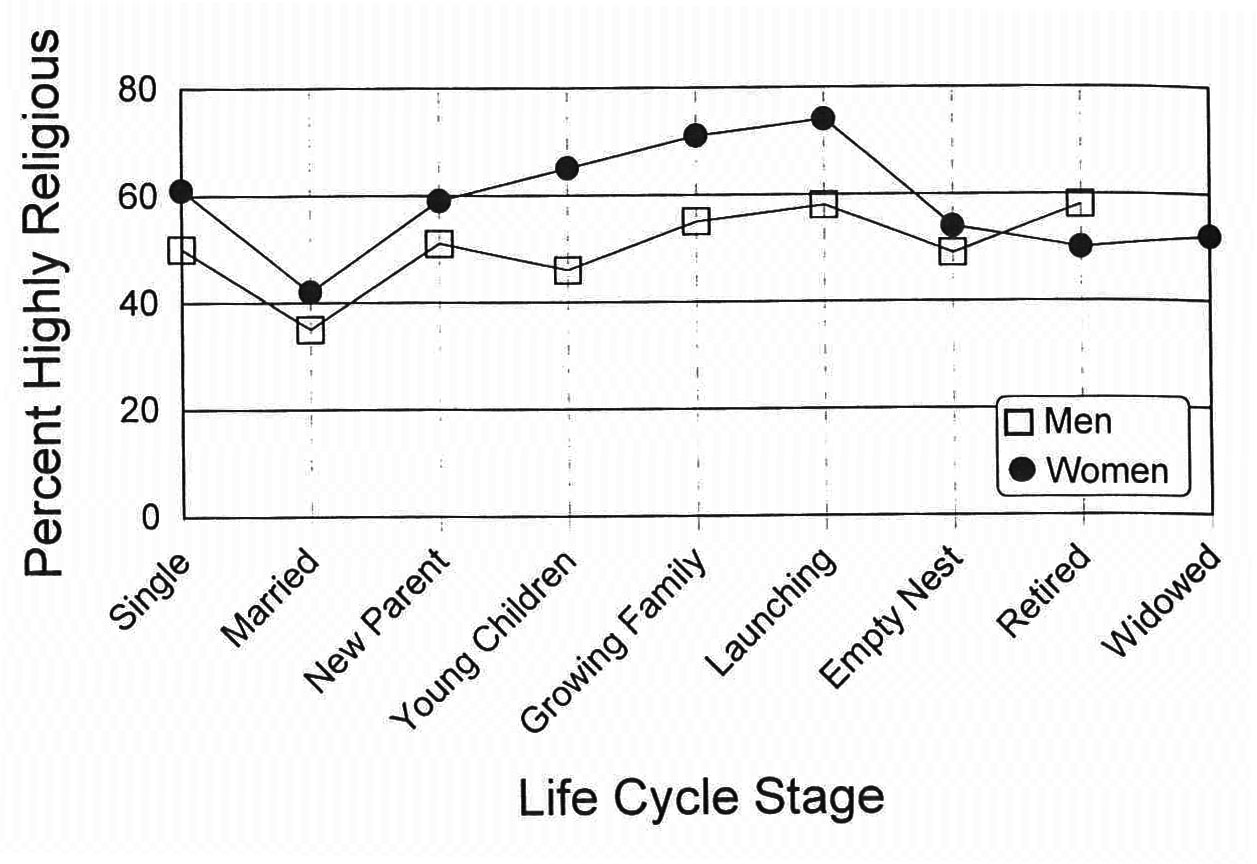
Figure 10.2: Percent High in Beatitudes, by Gender and Life Cycle Stage
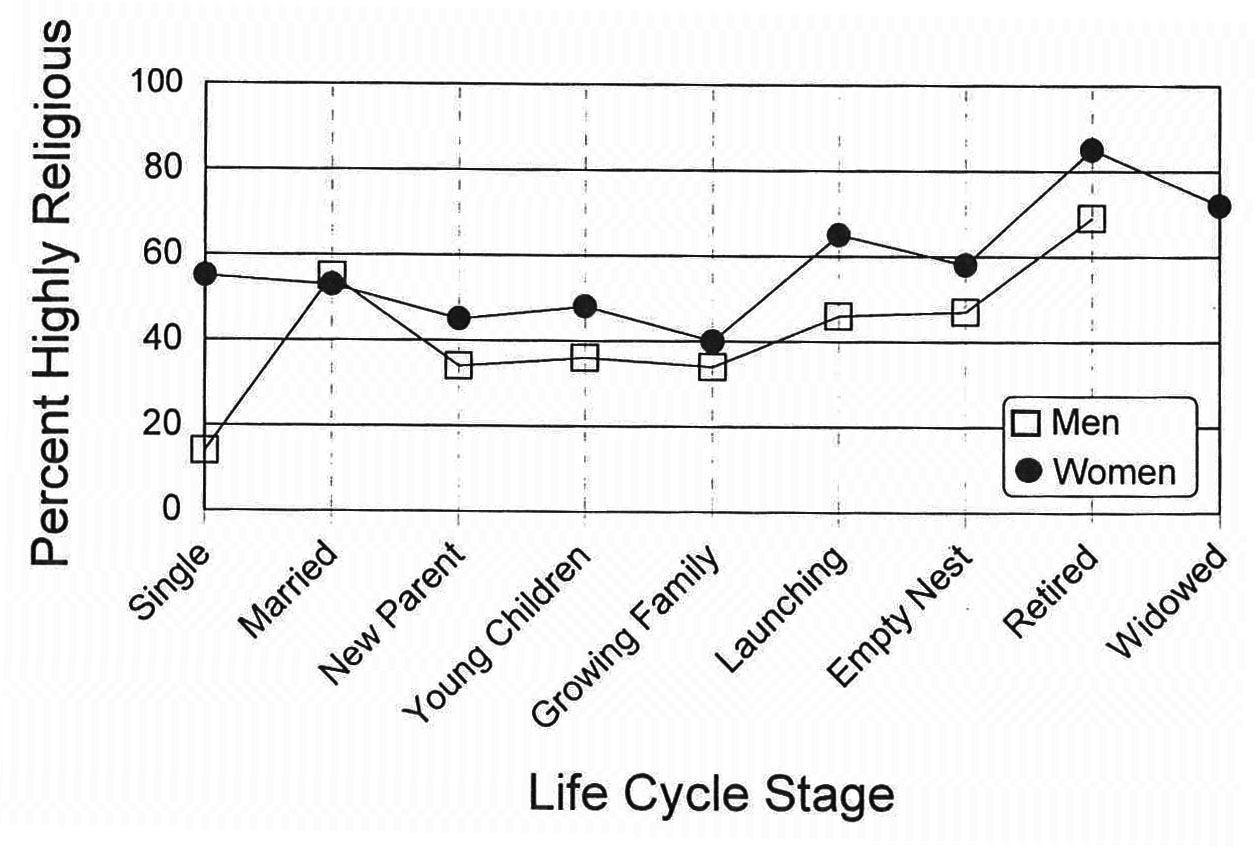
Beatitudes (fig. 10.2). The “beatitudes” factor was composed of six questions in which the respondents rated themselves as being gentle, kind, humble, patient, loving, and temperate. The overall trend for the beatitudes factor was a gradual increase in the percentage of people who were highly religious. Men were very low before marriage and then experienced a huge jump in these tender qualities upon marriage. Both men and women suffered a decline in the beatitudes upon the birth of the first child. This was followed by fairly consistent increases through the rest of life, with small downward variations especially at widowhood. Women were superior to men on these “beatitudes qualities,” except for a slight reversal immediately after marriage. Possible reasons for all of these trends will be explored later.
Integrity (fig. 10.3). The qualities of being honest and virtuous, rather than loading on the beatitudes factor, loaded on a separate factor we called “integrity.” Two things are especially notable about fig. 10.3. First, like the beatitudes factor, women were superior in integrity to men except for during one minor and insignificant period. The difference between men and women was not great, although it was consistent. Second, the long-term trend in integrity was upward—a higher and higher percentage of people rated themselves as having high integrity. Integrity did tend to lag during the early years of marriage, and men showed more variation in the first twenty years of marriage than did women. The reverse was true in the later stages of marriage, when women exhibited more variability and less consistency than men.
Service (fig. 10.4). Two other qualities—being of service to others and love of others—loaded on a third factor we called “service.” We expected these questions to be included in the beatitudes factor, but our respondents answered them sufficiently differently that they loaded on a separate factor. These three factors—beatitudes, integrity, and service—most fully represent what sociologists call “intrinsic religiosity,” which is the extent to which one’s religious devotion is prompted by inner religious motives and values. As in the other two intrinsic religiosity factors, women were higher than men in service, with a long-term trend toward an increased percentage of people rating themselves as highly religious. Men were briefly higher in the empty nest stage, where women suffered a downturn in service, but women again gained superiority in the retirement stage. Both men and women experienced a significant increase in service at the time of marriage and then a large decrease in service on the birth of their first child. So the long-term increase in service should be seen as beginning about the time of the birth of the second child.
Figure 10.3: Percent High in Integrity, by Gender and Life Cycle Stage
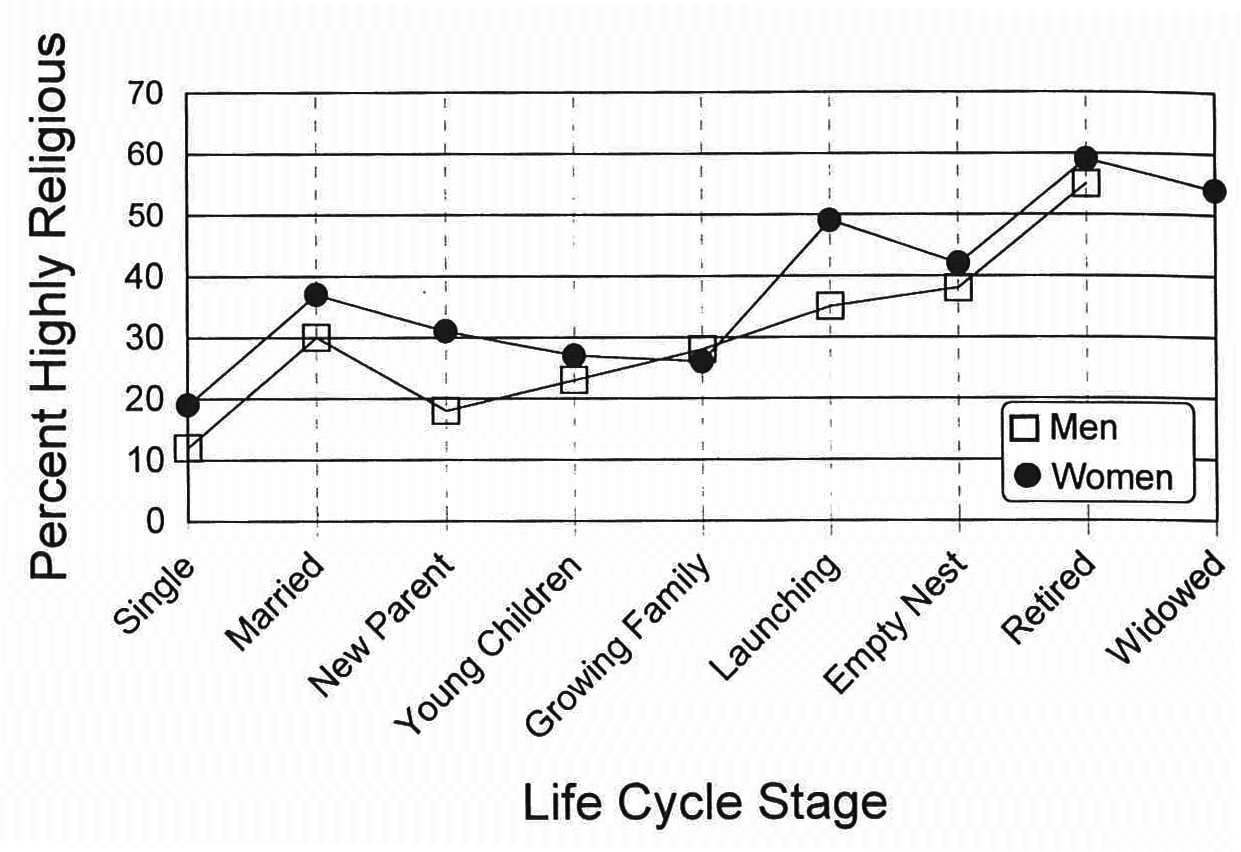
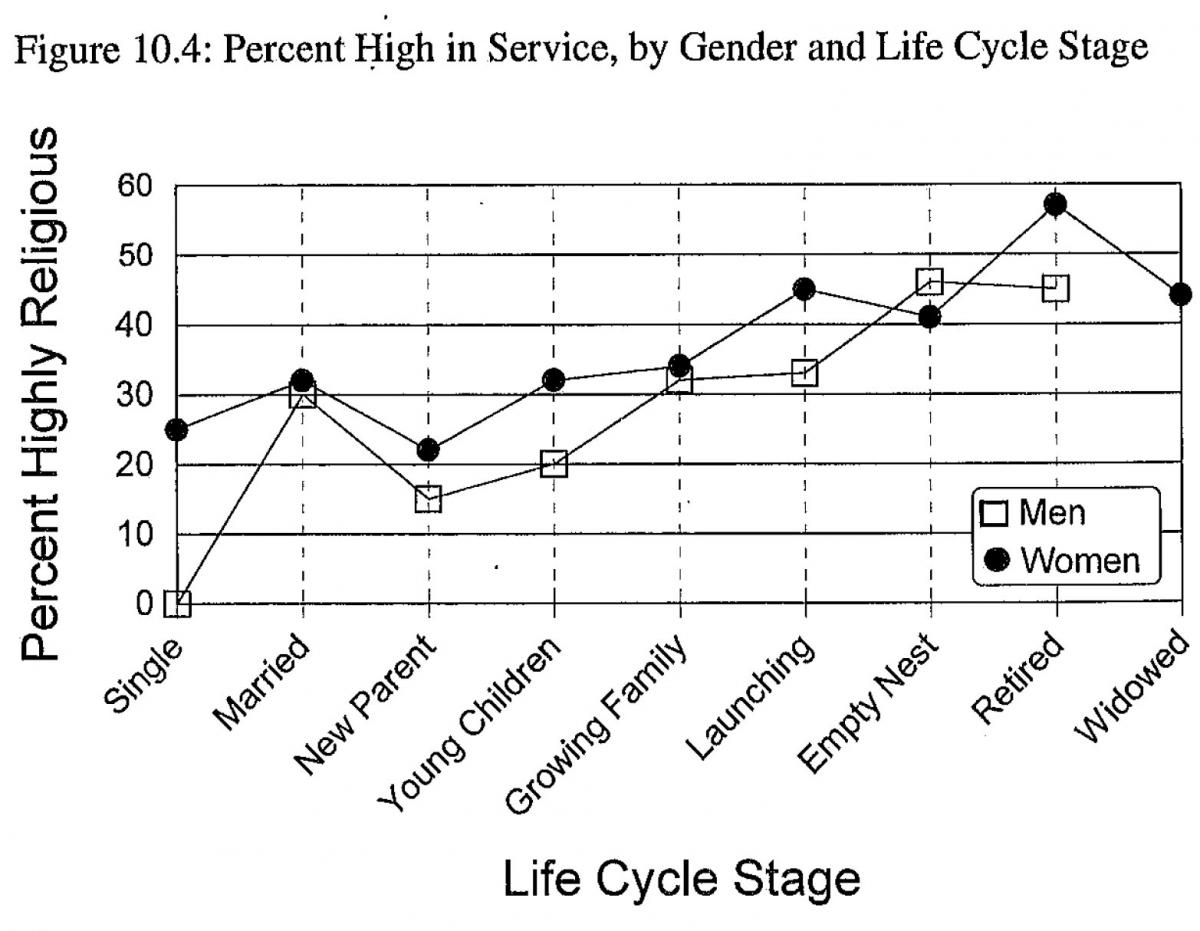
Figure 10.5: Percent High in Prayer, by Gender and Life Cycle Stage
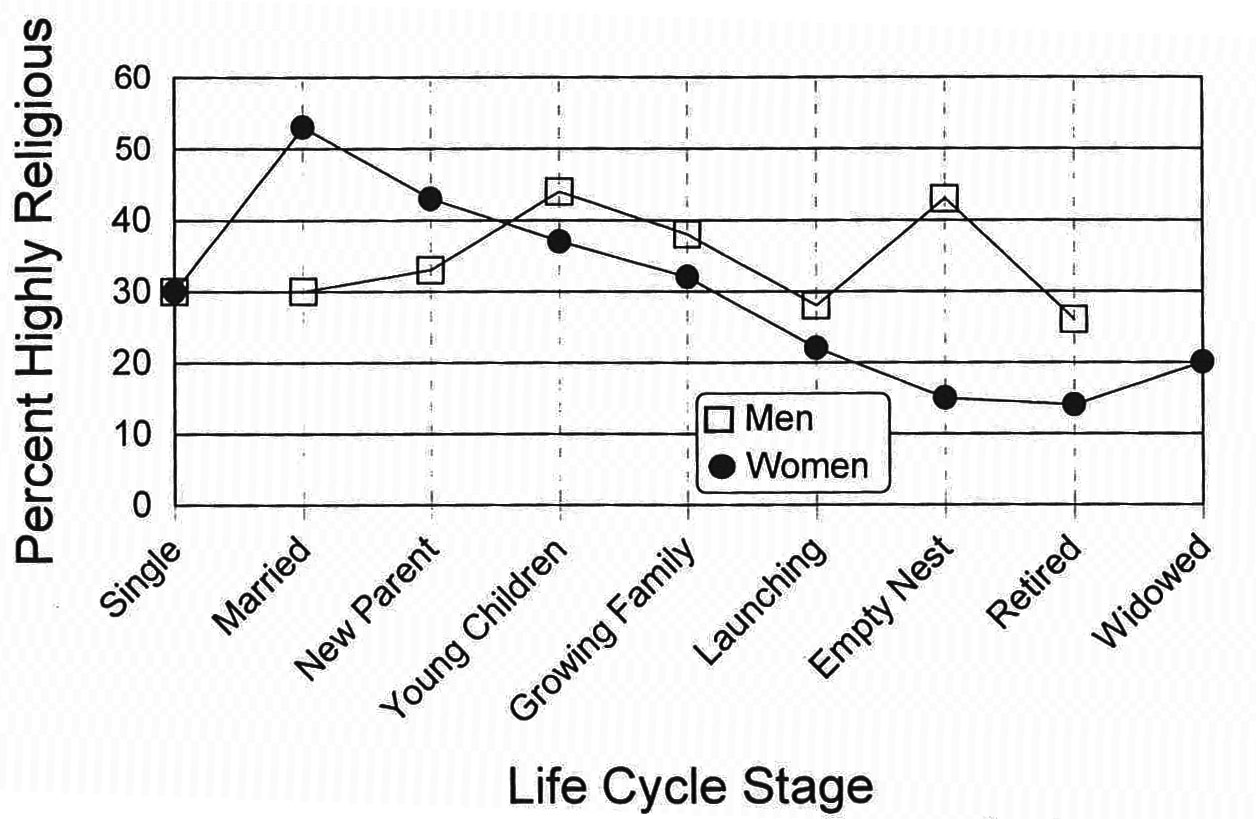
Prayer (fig. 10.5). Two questions loaded on the “prayer” factor—frequency of prayer and answers to prayer. This factor is often referred to as “private devotion,” and it showed trends that were distinctly different from other factors. In data which we do not report here, we found that some groups of people who were highly religious on most dimensions, such as high priests and their wives, rated themselves as being quite low on the prayer dimension. Conversely, divorced people, especially divorced women, were much more likely to pray daily than most other sub-groups, while their church attendance and feeling of spiritual well-being were relatively low. Prayer, then, is often used as a means of repentance, of strengthening one’s life and religious commitment, and as a compensator for weaknesses in other areas of religious life.
A fairly high percentage, about 30 percent, of Mormon people were highly religious on the prayer factor before marriage. After marriage, this percentage jumped sharply—more than twenty percentage points—for women, while remaining flat for men. At the birth of the first child, women experienced a decided decline in prayer while men showed a slight increase. Thereafter, the trend for women was a gradual but significant decrease in the percentage of women who were high on the prayer factor, with only a slight reversal in the last stage of widowhood. This decline, from a high of 53 percent in the just-married stage to a low of 14 percent in the retirement stage, was one of the most prolonged and significant changes in our data. Unfortunately, it was a negative change.
Men showed more variation, with increases at the birth of the second child and at the empty nest stage, and several significant decreases, especially at retirement. But overall the percentage of men who were high on the prayer factor was about the same at retirement as it was before marriage.
Testimony (fig. 10.6). Three questions loaded together on the testimony factor. These were belief that the LDS Church is the true church and self-ratings of the respondent’s testimony and faith. The overall trend was upward—toward an increasing percentage of people who had strong testimonies. In later life, approximately 70 percent of both men and women believed they had strong testimonies. Women again were more highly religious than men, although the percentage differences were not great. Women experienced a sharp increase when their youngest child was a teenager, a significant decrease in the empty nest stage, and then a significant increase again in the retirement stage.
Figure 10.6: Percent High in Testimony, by Gender and Life Cycle Stage
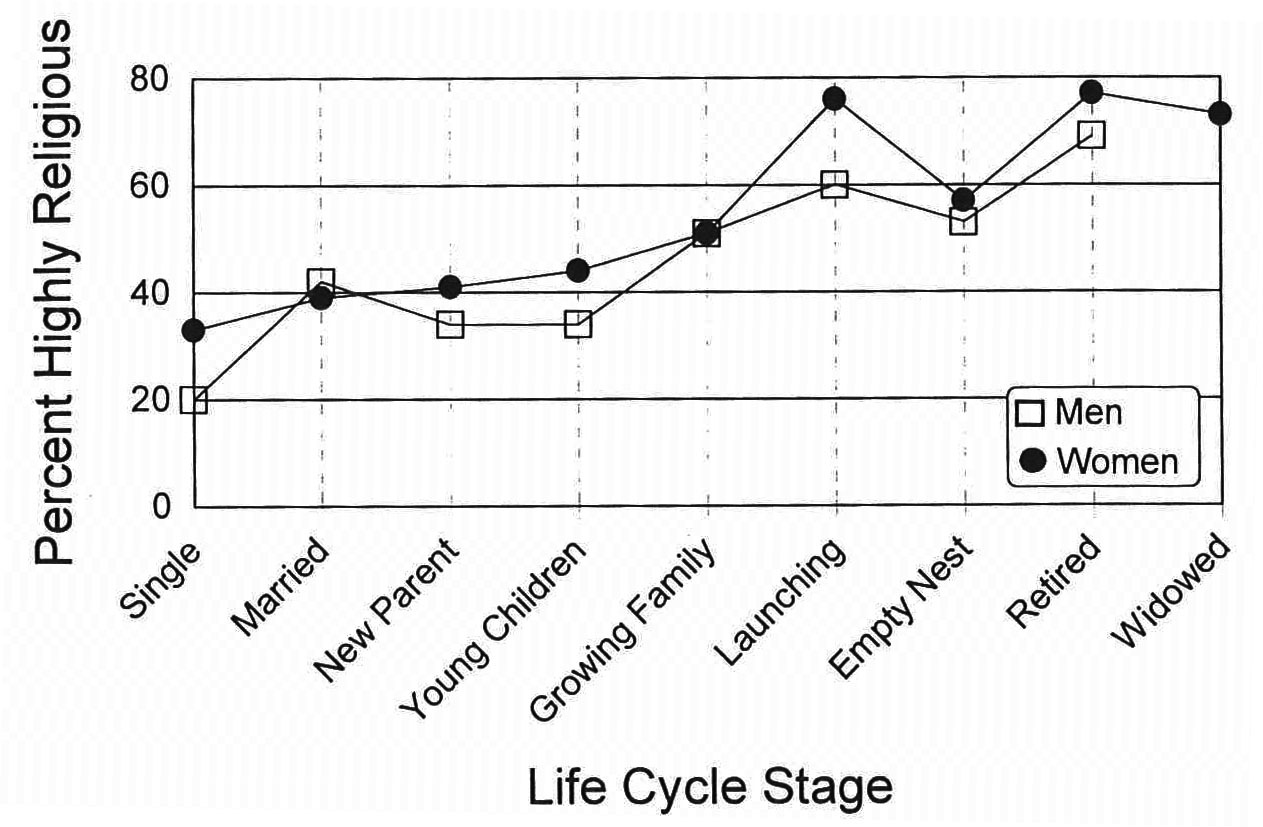
Spiritual Well-Being (fig. 10.7). The final factor was spiritual well-being, which included five questions: ratings of the respondent’s (1) knowledge of the gospel, (2) emulation of the life of Christ, and (3) overall religious devotion, as well as (4) how strong a Latter-day Saint respondents felt they were, and (5) what degree of glory they felt worthy to enter. These latter questions indicate how well people feel they are doing in the grand scale of life (Duke and Brown 1979). People who ranked high on this factor, then, seemed to feel that their lives were going well and that they were “right with God.”
Contrary to other factors, a greater percentage of men were high on this factor. Men started out very low in the single stage and then experienced a huge increase upon marriage. Through the life course there were many ups and downs for men, especially at the birth of the first child and at the empty nest stage. But the final trend was upward with over 50 percent rating themselves high in the retirement stage. Women were somewhat less variable than men. They experienced declines in spiritual well-being at marriage and at the birth of the first child, increases through the childrearing years, a notable decline at the empty nest stage, and then increases again through old age.
Figure 10.7: Percent High in Spiritual Well-Being, by Gender and Life Cycle Stage
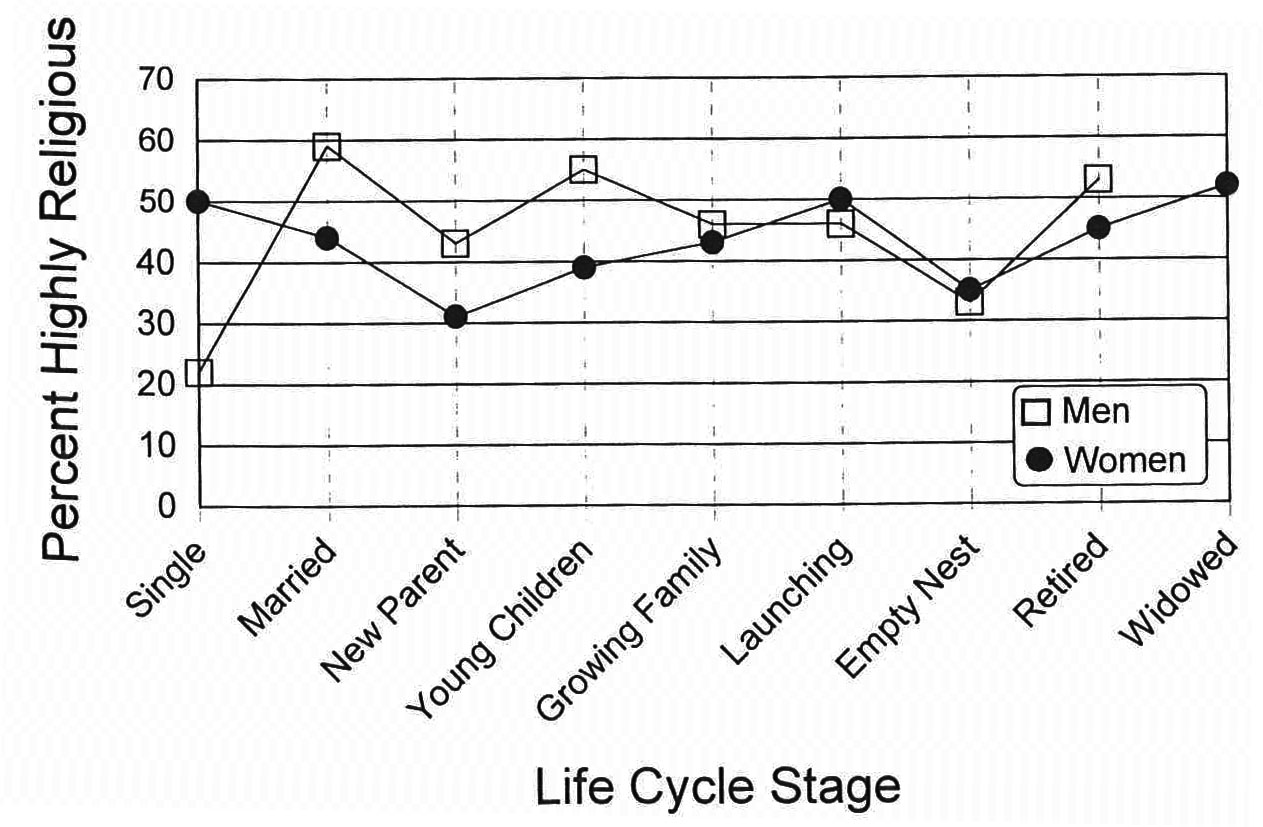
Figure10.8: Percent High in Total Religiosity, by Gender and Life Cycle Stage
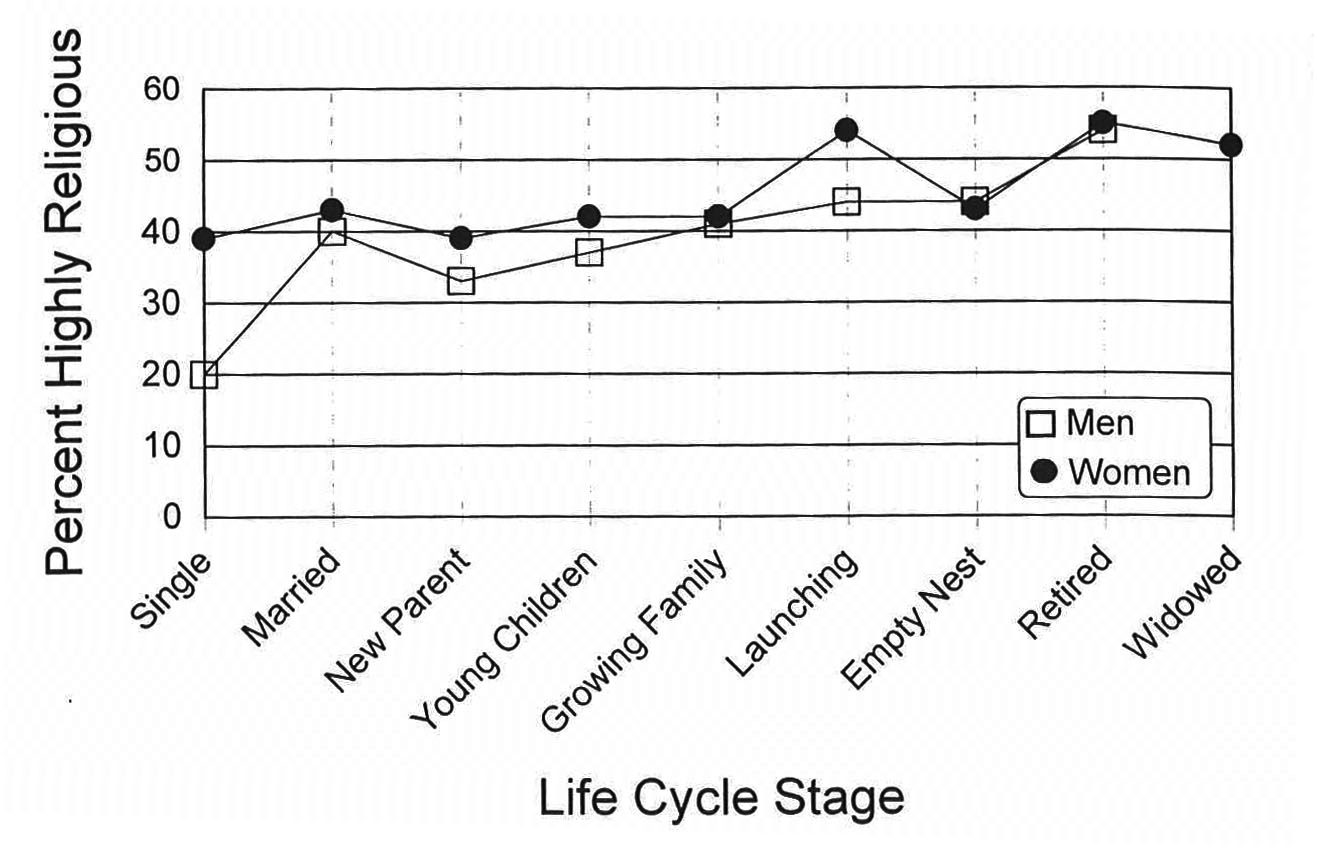
Total Religious Devotion (fig. 10.8). Finally, we created a “total” religious devotion score that represents the average of all the seven factors. We used this as an indicator of what is sometimes called “global religiosity,” a rating of the total religious life of the individual when every dimension of religiosity is taken into account.
As the graph in fig. 10.8 shows, the total religious devotion of Mormon respondents generally increased through the life cycle, being relatively low, especially for men, in the single stage and increasing through retirement and widowhood. Women were more highly religious than men in the first six stages, but men and women were almost identical in the empty nest and retirement stages. Men demonstrated a significant increase upon marriage. Women experienced a large increase when the youngest child was a teenager, a sharp drop when all the children left home, and a large increase again about the age of retirement.
The Effect of Each Life Cycle Stage
Having summarized the trends for each of our measures of religious devotion, we now look specifically at each life cycle stage and discuss more fully the effect each stage has on both men and women. Table 10.4 presents data on the percent of people classified as having high total religious devotion in each stage of the life cycle. We also show the average change in the percent who were highly religious in each stage.
The Single State. There were relatively few respondents who were unmarried and under thirty-five years of age. Among the ten single men, the level of religious devotion was extremely low, with only 20 percent categorized as highly religious. Single women were considerably more religious, with 39 percent highly religious. Many single men tend to become inactive in their late teens and early twenties (Albrecht, Cornwall, and Cunningham 1988; Bahr and Albrecht 1989) as they seek independence, experiment with lifestyles different from those of their parents, and become self-centered and individualistic. Single women, on the whole, appear to be more committed to the church and its teachings at this stage of their lives.
Marriage. Marriage had a powerful influence on men. Newly married men were much more religious than single men. The percent of men who scored in the high range of religious devotion doubled from 20 percent to 40 percent. For men, this was the most significant period of growth in religious devotion during the entire life cycle. Women also experienced growth in religious devotion upon marriage, but their change was relatively modest, from 39 percent of respondents to 43 percent.
After marriage, men showed particularly high growth on the beatitudes and spiritual well-being dimensions, moderate increases in service, testimony and integrity, and declined only in church attendance. Marriage appears to have a softening and tempering effect on men, changing them most significantly in the intrinsic aspects of religious devotion.
From the point of view of Church teachings, growth in intrinsic religious devotion is a consequence of love, devotion, caring, service, and sacrifice, all of which are more likely to be practiced in a close relationship with a loved spouse. Single persons are probably more concerned for their own needs than are married people, but they may also recognize that such a self-orientation is not consistent with their own religious values. Newly married people become involved in the developmental task of establishing and enhancing a relationship with a loved one, and therefore become more concerned with helping and serving that person. Men probably experience this shift from self-concern to concern for another person more than do women, because such service is less a part of the role definition of the single male. But whatever the explanation, Mormon men do appear to become much more religious, especially in the intrinsic dimensions of religion, in the first year or two of marriage.
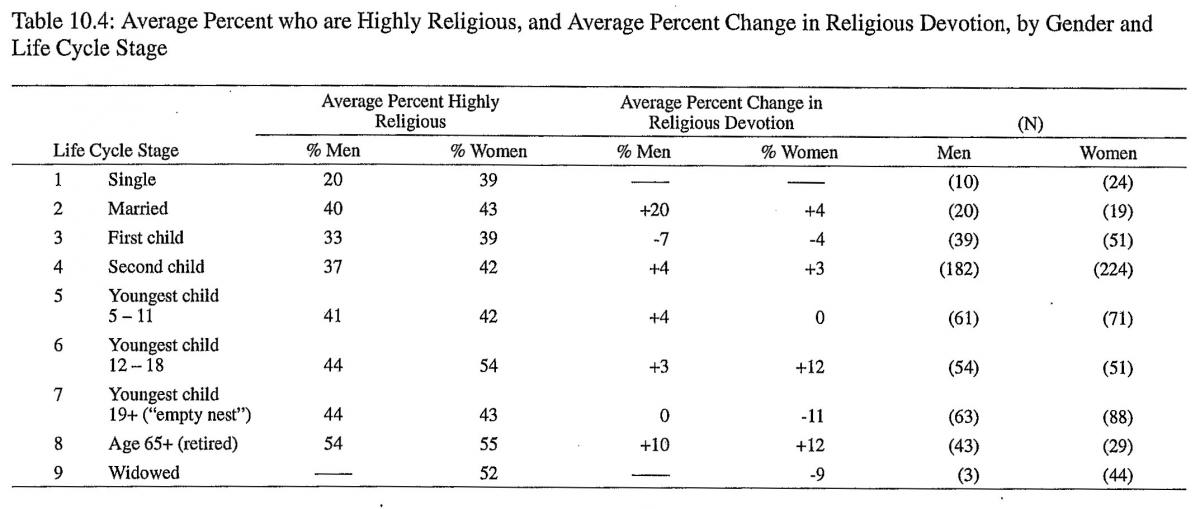
Mormon women experienced large increases in the integrity and prayer factors and a substantial decrease on the public devotion factor, with other changes much more modest. It is significant to note the decline in public devotion (mostly church attendance) for both men and women during this first year or so of marriage. Church attendance in the single state may have a large social component and be part of the acquaintanceship process during courtship, especially for Latter-day Saint young adults. Once married, there occurred a short and temporary decline in public devotion, perhaps due to the lower supervision of parents over church attendance and the adjustments attendant to marriage.
The Birth of the First Child. In many Mormon marriages the birth of the first child follows a year or two after marriage, so the interval between marriage and parenthood is relatively brief. The growth of religious devotion at marriage was reversed at the birth of the first child, with a decline in the percentages of both men and women scoring high in religious devotion. The decline was larger for men than for women.
For men, the most significant declines were in beatitudes, spiritual well-being, service, and integrity, precisely those intrinsic aspects that had shown the greatest growth at marriage. Mormon men believe they are less loving, warm, and sharing. Although we have no data on the parallel job histories of these respondents, it is at this time that the husband is most likely to complete school and to be under pressure to establish his occupational career.
One notable finding was that public devotion again underwent a change opposite to most other religious devotion factors. Church attendance increased at the birth of the first child while other dimensions were declining. Parenthood perhaps puts greater social pressure on parents to attend church services and motivates them to establish more consistent attendance habits. Church attendance may also be a means of compensating for the perceived decline in the other dimensions of religious devotion; if one observes that one’s kindness and feeling of religious self-worth are declining, church attendance may be a means to reverse that trend.
Motherhood is an especially significant transition in the life of the young Mormon woman, but this transition does not appear to have as great an influence on religious devotion as it does on other aspects of the young mother’s life. Mormon women experienced approximately the same changes in religious devotion that men did, but the changes were not as extensive or extreme. The most significant increase was in public devotion, while moderate decreases were experienced in spiritual well-being, service, prayer, beatitudes, and integrity. Again, we attribute these declines primarily to the pressures experienced in adjusting to parenthood and the added responsibilities of the woman in non-religious roles.
Why was there a decline in the intrinsic dimensions of religiosity, and why was this decline more significant for men than for women? One explanation is that the added pressures of child-care, even though anticipated and desired in most cases, resulted in the individual being more tired, impatient, and perhaps frustrated. The needs of the parents for affection, caring, and emotional response may not have been met to the same degree as during the period before the birth of the first child.
The love and warmth poured out upon the child could be expected to lead to an increase in the intrinsic aspects of religiosity, but these were offset by impatience and frustration as the new parents sought to adjust to the new role of parent, to meet the needs of the child, and to adjust to a loss of sleep. The father probably experienced less growth from the nurturing process devoted to the child in his new role of parent than did the mother.
The Birth of the Second Child. As the parents became established in their marriage and in their parental roles, the percentage of people who were highly religious again increased. At the birth of the second child, both men and women showed slight overall increases, including increases on five of the seven factors. The birth of the second child was probably not experienced as requiring the same level of adjustment as either marriage or initial parenthood. Most parents with a second child probably had completed their education, had entered upon their careers, and perhaps were feeling less stress as life progressed.
The Aging of Children. With older children in the family (stages five and six), there was a continuation of the increase in religious devotion noted at the birth of the second child. This increase was substantial for both men and women, but was especially strong for women, especially as their children became teenagers—a paradoxical and non-intuitive finding. Men increased on five dimensions, with an especially notable increase of 26 percent in testimony, and showed moderate increases in beatitudes, integrity, service, and public devotion, while experiencing declines in prayer and spiritual well-being. Mormon women likewise showed a large increase—32 percent in testimony, with all other dimensions displaying moderate to strong increases except prayer.
Why there should be such notable increases in testimony for both men and women is not immediately apparent. We believe it is due primarily to the experiences of parenthood, which give people practice in living and teaching the theological principles they have learned previously. They come to see validity and truth in such principles, which strengthens their belief that the Church is true, that the principles are not just social in origin but have been revealed by God through his prophets, and that they have practical applications in the mortal world.
At the same time there was a decline in prayer. As noted previously, the prayer factor was the most dissimilar to the other factors. Persons with high scores on prayer often were people with significant problems, such as illness, divorce, separation, or other family challenges. Prayer may have been a source of solace and reassurance for such people. Conversely, people who were otherwise strong in their religious devotion, such as high priests and their wives, were relatively low on the prayer dimension. Possibly prayer was taken for granted, and perhaps neglected, as other aspects of life became more comfortable and strong. The lack of a strong prayer life among otherwise highly religious people is one of the most important findings of this study and should be a matter of deep concern for leaders and members of the Church.
The Empty Nest Stage. The changes in religious devotion that occurred at the empty nest stage were especially interesting and significant. On balance, men showed neither growth nor decline in religious devotion. The percentage of men with high total religious devotion remained stable, while four factors increased and three factors decreased. On balance, the transition experienced by fathers as their children left home did not have a substantial effect on their religious devotion.
The same cannot be said of the Mormon mothers in the sample. The empty nest stage had a very strong negative impact on their self-reported religious devotion. The average decline was 11 percent, and a decline was evidenced on all seven factors. The greatest declines were in public devotion, testimony, and spiritual well-being.
On questions concerning happiness (not reported here), there was a gradual increase rather than decline in overall happiness during the transition from childrearing to the empty nest stage, which is consistent with research on Americans in general. By this measure the transition does not appear to be a traumatic one. But the empty nest situation had a significant impact on the religious devotion of women.
In Mormon families, both the mother and father roles are defined in religious terms. However, the mother role may be more important to a woman’s sense of well-being than is the father role for a man. The decline in religious devotion does not appear to have been the result of aging, cohort or period effects, or to other social conditions. It occurred specifically at the time that the Mormon mother lost her most consuming and responsible role, one she had played for twenty to thirty years and which had been a chief means by which status had been achieved within the Mormon community.
Service to and sacrifice for her family had been a significant part of the mother’s life for many years, and much of this service was viewed in religious terms: one serves God by serving and loving others, especially one’s family. Thus the loss of people whom one can serve led to a decline in intrinsic aspects of religiosity and to the devotional aspects as well. Such a decline is significant but did not last long.
Retirement. Many people retire before or after the age of sixty-five, but we chose this age as the typical landmark in the life cycle of most Americans. There were substantial increases in the percentage of both men (an increase of 10 percent) and women (an increase of 12 percent) with high total religious devotion at this stage. The people we are considering here were still in intact first marriages, because divorcees, remarried people, and those who had never married were excluded from these life cycle analyses. Therefore, these respondents had been married for many years, their families were grown and gone, and they were now facing retirement and old age with the companionship of their spouse.
Men showed moderate to high increases in beatitudes, integrity, spiritual well-being, testimony, and public devotion, while showing a substantial further decline in prayer. Perhaps the loss of occupational status was compensated for with a renewed activity in church attendance. Men felt better about themselves and their religious lives, and the church appeared to be a very important part of their lives during this stage.
Women exhibited an even more substantial increase than did men at this stage. Increases in religious devotion reversed and perhaps compensated for the decline experienced in the prior empty nest stage. Beatitudes showed the greatest increase, but strong increases were also observed in testimony, integrity, service, and spiritual well-being. Slight decreases for women occurred in public devotion and prayer.
One would imagine that retirement would have a greater impact on the husband than on the wife, but these data do not support such a conclusion. Both husbands and wives experienced a substantial increase in religious devotion. Perhaps the greater increase for women was a response to the decline experienced earlier. At the least, this appears to be a happy and comfortable stage where religious devotion (except prayer) is especially high.
Widowhood. The final life cycle stage to be considered is widowhood, in which a significant rupture has occurred to a long-held social relationship, and which usually leaves the widow more socially isolated. There were only three widowers in the sample, which probably reflects a greater likelihood for husbands to predecease their wives and for male widowers to remarry. Therefore, our analysis can only be done for the forty-four widows in the sample.
Widows experienced a substantial decline in global happiness at this time, but this was not matched by an equally strong decline in religious devotion. A slightly lower number of widows were highly religious, but this decline was accounted for almost entirely by decreases in beatitudes and service. These declines may have occurred because of the emotional and social stresses incident to aging, but probably were due to the loss of relationships that allow the giving of service, love, and kindness. While public devotion was not at the same levels it was during the childrearing years, it remained remarkably high for these widows. Religion may serve as a refuge in an otherwise stressful period. There was no evidence that Mormon widows face death with either a marked increase or decrease in religious devotion. Consistency rather than change tends to mark this life cycle stage.
Religious Devotion and Aging
There has been much debate among gerontologists concerning the influence of religion on aging (Levin 1989, pp. 34-138). We will briefly discuss four points of view here. Some gerontologists hypothesize that people grow more religious as they grow older and as death approaches (the so-called “eschatological” theory). Others support the “disengagement” point of view that older people withdraw from most endeavors, including religion, as they grow older. A third point of view, called “isolation theory,” is that older people become isolated and decline in church attendance, often against their will. Lastly, some experts believe that older people decrease in church attendance while increasing in private religious devotion such as prayer and scripture study. This latter is called the “multiple disengagement” perspective. Levin believes the latter point of view best fits the data on religion and aging.
We found that both Mormon men and women experience a substantial increase in religious devotion in the retirement stage, followed by a very slight decrease in religious devotion of widows after the death of their husbands. The eschatological perspective, therefore, seems to apply better to the retirement stage than to the widowhood stage. None of the four models seems to capture the experience of Mormon widows exactly, since they increase slightly in public devotion, prayer, and spiritual well-being, while decreasing in beatitudes, integrity, service, testimony, and total religious devotion. We saw little evidence of disengagement per se or of isolation among these LDS people, although such situations probably occur in some cases.
Generally, the religious devotion of older people was considerably higher than that of younger people. In examining general changes in religious devotion through the course of people’s lives, the increase in religious devotion for men was very great, while women demonstrated more consistency and less contrast. Men showed more variation or irregularity in the early stages of the life cycle (one through three), while women showed greater variation in religious devotion in the later stages (five through eight). Perhaps the challenges faced by men were greater in early adulthood, while those faced by women were greater in later life.
Summary and Conclusion
In summary, young single men were especially low in religious devotion before marriage. Religious devotion increased at marriage, especially for men. At the birth of the first child, religious devotion decreased for both men and women. After the birth of subsequent children, and during most of the child-raising years, religious devotion again increased, with the increase higher for women than for men. There was an especially high increase in testimony during the child-rearing period. The empty nest stage had a strong negative impact on the religious devotion of women but no impact on men. However, the religious devotion of women made a quick and sharp recovery upon retirement. The retirement years were especially good ones as reflected in high scores on most dimensions of religious behavior. Finally, widowhood had relatively little impact on the religious devotion of women, with only a slight decrease in total religious devotion.
In conclusion, this study investigated the substantial changes in religious devotion that take place as a result of changes in the life cycle. While further research is necessary before we can understand these changes fully, many of the dynamics of religious behavior and attitudes can be understood better by taking into account the specific life cycle stage of the individual. Personal development during the life cycle, and the accompanying challenges and opportunities generated by changes in people’s life-situations, appear to have a significant impact upon religious devotion, at least for American Mormon families.
References
Albrecht, Stan L. and Marie Cornwall. 1989. “Life Events and Religious Change.” Review of Religious Research 31:23–38. Also in this volume.
Albrecht, Stan L., Marie Cornwall, and Perry H. Cunningham. 1988. “Religious Leave-Taking: Disengagement and Disaffiliation among Mormons.” Pp. 62–80 in Falling from the Faith: The Causes and Consequences of Religious Apostasy, edited by David G. Bromley. Newbury Park, CA: Sage.
Albrecht, Stan L. and Tim B. Heaton. 1984. “Secularization, Higher Education, and Religiosity.” Review of Religious Research 26:43–58. Also in this volume.
Bahr, Howard M. and Stan L. Albrecht. 1989. “Strangers Once More: Patterns of Disaffiliation from Mormonism.” Journal for the Scientific Study of Religion 28:180–200.
Bengtson, Vern L. and Katherine R. Allen. 1993. “The Life Course Perspective Applied to Families Over Time.” Pp. 469–99 in Sourcebook of Family Theories and Methods, edited by Pauline Boss, William J. Doherty, Ralph LaRossa, Walter R. Schumm, and Suzanne K. Steinmetz. New York: Plenum.
Bergin, Allen E., I. Reed Payne, Paul H. Jenkins, and Marie Cornwall. 1994. “Religion and Mental Health: Mormons and Other Groups.” Pp. 138-58 in Contemporary Mormonism: Social Science Perspectives, edited by Marie Cornwall, Tim B. Heaton, and Lawrence A. Young. Urbana, IL: University of Illinois Press.
Chaves, Mark. 1989. “Secularization and Religious Revival: Evidence from U.S. Church Attendance Rates, 1972-1986.” Journal for the Scientific Study of Religion 28:464-77.
Clements, William M, ed. 1989. Religion, Aging and Health: A Global Perspective. New York: Haworth.
Cornwall, Marie. 1989. “The Determinants of Religious Behavior: A Theoretical Model and Empirical Test.” Social Forces 68:572–92. Also in this volume.
———. 1994. “The Institutional Role of Mormon Women.” Pp. 239–64 in Contemporary Mormonism: Social Science Perspectives, edited by Marie Cornwall, Tim B. Heaton, and Lawrence A. Young. Urbana, IL: University of Illinois Press.
Cornwall, Marie, Stan L. Albrecht, Perry H. Cunningham, and Brian L. Pitcher. 1986. “The Dimensions of Religiosity: A Conceptual Model with an Empirical Test.” Review of Religious Research 27:226–44. Also in this volume.
Cornwall, Marie, Tim B. Heaton, and Lawrence A. Young, eds. 1994. Contemporary Mormonism: Social Science Perspectives. Urbana, IL: University of Illinois Press.
Coser, Rose L. 1989. “Reflections on Feminist Theory.” Pp. 200–7 in Feminism and Sociological Theory, edited by Ruth A. Wallace. Newbury Park, CA: Sage.
Davie, Grace. 1994. Religion in Britain since 1945. Oxford, UK: Blackwell.
Dillman, Don A. 1978. Mail and Telephone Surveys: The Total Design Method. New York: Wiley.
Duke, James T. and Barry L. Johnson. 1984. “Spiritual Well-Being and the Consequential Dimension of Religiosity.” Review of Religious Research 26:59–72.
Duke, James T. and D. Wayne Brown Jr. 1979. “Three Paths to Spiritual Well-Being among Mormons: Conversion, Obedience, and Repentance.” Pp. 173–89 in Spiritual Well-Being: Sociological Perspectives, edited by David O. Moberg. Washington, DC: University Press of America.
Duvall, Evelyn. 1977. Family Development. Philadelphia: Lippincott.
Elder, Glenn H. Jr. 1991. “Lives and Social Change.” Pp. 58–86 in Theoretical Advances in Life Course Research, edited by Walter R. Heinz. Wein-heim: Deutscher Studien Verlag.
Fowler, James W. 1981. Stages of Faith: The Psychology of Human Development and the Quest for Meaning. San Francisco: Harper and Row.
———. 1991. Weaving the New Creation: Stages of Faith and the Public Church. San Francisco: Harper.
Fuller, Robert C. 1988. Religion and the Life Cycle. Philadelphia: Fortress.
Gallup Opinion Index. 1993. Religion in America 1992–93. Princeton, NJ: Princeton Religious Research Center.
Glock, Charles Y. and Rodney Stark. 1965. Religion and Society in Tension. Chicago: Rand McNally.
Hadaway, C. Kirk, Penny L. Marler, and Mark Chaves. 1993. “What the Polls Don’t Show: A Closer Look at U.S. Church Attendance.” American Sociological Review 58:741–52.
Heaton, Tim B., Kristen L. Goodman, and Thomas B. Holman. 1994. “In Search of a Peculiar People: Are Mormon Families Really Different?” Pp. 87–117 in Contemporary Mormonism: Social Science Perspectives, edited by Marie Cornwall, Tim B. Heaton, and Lawrence A. Young. Urbana, IL: University of Illinois Press.
Iannaccone, Laurence R. and Carrie A. Miles. 1994. “Dealing with Social Change: The Mormon Church’s Response to Change in Women’s Roles.” Pp. 265–86 in Contemporary Mormonism: Social Science Perspectives, edited by Marie Cornwall, Tim B. Heaton, and Lawrence A. Young. Urbana, IL: University of Illinois Press.
Levin, Jeffrey S., ed. 1994. Religion in Aging and Health. Thousand Oaks, CA: Sage.
. 1989. “Religious Factors in Aging, Adjustment, and Health: A Theoretical Overview.” Pp. 133-46 in Religion, Aging and Health: A Global Perspective, edited by William M. Clements. New York: Haworth.
Levy, Rene. 1991. “Status Passages as Critical Life Course Transitions: A Theoretical Sketch.” Pp. 87-114 in Theoretical Advances in Life Course Research, edited by Walter R. Heinz. Weinheim: Deutscher Studien Verlag.
Mattessich, Paul and Reuben Hill. 1987. “Life Cycle and Family Development.” Pp. 437–69 in Handbook of Marriage and the Family, edited by Marvin Sussman and Susan Steinmetz. New York: Plenum.
Rollins, Boyd C. and Kenneth L. Cannon. 1974. “Marital Satisfaction over the Family Life Cycle: A Reevaluation.” Journal of Marriage and the Family 36:271–82.
Roof, Wade Clark. 1979. “Concepts and Indicators of Religious Commitment: A Critical Review.” Pp. 17–45 in The Religious Dimension: New Directions in Quantitative Research, edited by Robert Wuthnow. New York: Academic Press.
Thomas, L. Eugene and Susan A. Eisenhandler, eds. 1994. Aging and the Religious Dimension. Westport, CN: Auburn House.
Vaillant, Caroline O. and George E. Vaillant. 1993. “Is the U-Curve of Marital Satisfaction an Illusion? A 40-Year Study of Marriage.” Journal of Marriage and the Family 40:230–39.
